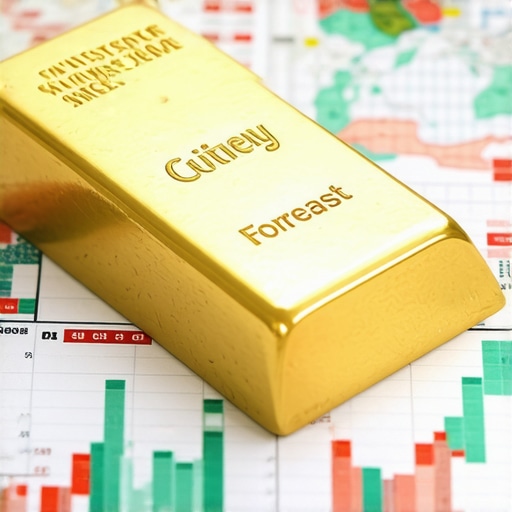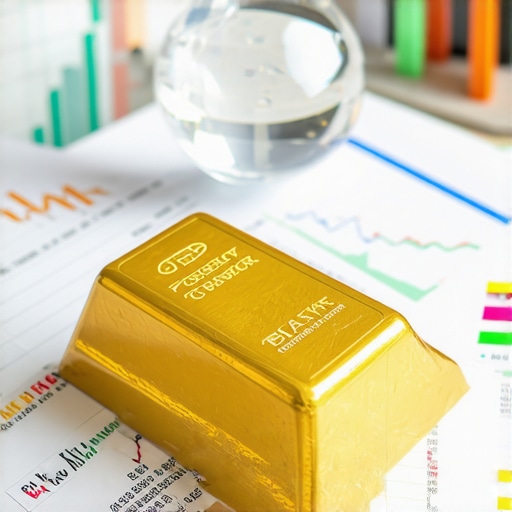Unlocking the Secrets Behind Gold Price Movements: An Expert’s Perspective
Gold has long been heralded as a safe haven asset, especially in turbulent economic times. However, forecasting its price is far from straightforward. Investors aiming to prepare their portfolios must go beyond mere speculation and embrace sophisticated forecasting techniques that incorporate both quantitative data and qualitative insights. Understanding these methods can empower you to anticipate market shifts and allocate your assets with confidence.
Decoding Market Signals: Technical Analysis and Gold Price Trends
Technical analysis remains a cornerstone for many gold investors. By studying historical price charts, trend lines, and volume indicators, traders can identify patterns such as head-and-shoulder formations, moving average crossovers, and Fibonacci retracements. These signals often reveal potential support and resistance levels, enabling investors to forecast short- and medium-term price movements effectively. For those seeking a deeper dive into key gold price trends and market signals, this resource offers comprehensive guidance.
Macro Forces at Play: Economic Indicators Influencing Gold Price Forecasting
Gold’s value is intricately linked to global economic factors such as inflation rates, currency strength — notably the US dollar — and geopolitical uncertainty. Inflation erodes fiat currency value, often driving investors toward gold as a hedge. Similarly, fluctuations in the dollar inversely affect gold prices, given gold’s dollar-denominated market. Seasoned forecasters integrate these macroeconomic indicators using econometric models to predict gold’s trajectory. For example, during periods of rising inflation expectations, gold typically experiences upward pressure, a relationship well documented by the World Gold Council (source).
What Are the Most Reliable Techniques for Forecasting Gold Prices Today?
Among the myriad forecasting methods, combining technical analysis with fundamental economic data yields the most robust forecasts. Advanced predictive models, such as machine learning algorithms, are gaining traction by analyzing vast datasets encompassing historical prices, global supply-demand dynamics, and investor sentiment from news and social media. Moreover, monitoring gold futures market activity can provide actionable insights on market expectations and hedging behaviors. Investors interested in futures strategies can explore effective gold futures trading techniques to enhance their tactical approach.
Building a Resilient Portfolio: Strategic Applications of Gold Price Forecasts
Integrating forecasting techniques into portfolio management enables investors to optimize asset allocation, hedge against inflation, and minimize risks associated with market volatility. For instance, during anticipated gold price rallies, increasing physical gold holdings or gold-backed ETFs can provide diversification benefits. Conversely, understanding forecast limitations is crucial; unexpected geopolitical shocks or sudden shifts in monetary policy can disrupt even the most sophisticated models. Therefore, flexibility and continuous monitoring are essential components of a successful strategy.
Engage with your portfolio strategy today – share your experiences or questions on gold price forecasting in the comments below to foster a community of informed investors.
Personal Lessons from Gold Market Fluctuations
Reflecting on my own journey with gold investing, I recall the unpredictability that initially caught me off guard. Early on, I was drawn to gold as a safeguard against economic uncertainty but quickly realized that no forecast method is foolproof. One particular instance stands out: during a period when inflation was expected to rise sharply, many forecasts predicted a gold price surge. While the price did climb, it was a more gradual increase than models had anticipated. This experience taught me the value of patience and the importance of combining forecasts with ongoing market observation rather than relying solely on initial predictions.
Balancing Quantitative Data with Intuition
Although technical and fundamental analyses provide invaluable frameworks, I’ve found that a seasoned investor’s intuition, honed through experience, plays an essential role. For example, understanding geopolitical tensions often requires interpreting subtle signals beyond data charts—things like diplomatic rhetoric or unexpected policy announcements. These qualitative insights can sometimes prompt timely adjustments to one’s portfolio before quantitative models catch up. To deepen your understanding of gold investment strategies, especially if you’re considering physical assets, exploring guides like physical gold buying best practices can be highly beneficial.
How Can Investors Stay Ahead in an Ever-Changing Gold Market?
This question has lingered with me throughout my investment journey. Staying ahead means embracing a mindset of continuous learning and flexibility. Markets evolve, and so do the drivers behind gold prices—from shifts in central bank policies to emerging global economic challenges. Leveraging trusted sources for current market analysis, such as the World Gold Council, helps keep one informed of broader trends and subtle shifts in demand and supply dynamics. According to the World Gold Council, gold’s role as a hedge against inflation and currency fluctuations remains robust, but investors must be vigilant about emerging market signals (source).
Practical Tips for Integrating Gold into Your Portfolio
From my experience, diversification within your gold holdings can significantly mitigate risk. For example, a combination of physical gold, gold ETFs, and gold mining stocks can balance liquidity needs with growth potential. Physical gold offers tangible security, while ETFs provide ease of trading and liquidity. If you’re curious about how these options stack up, resources like physical gold versus ETFs investment insights offer thorough comparisons.
Also, consider the timing and storage logistics of physical gold. Secure storage solutions and trustworthy dealers are paramount to protect your investment, which you can explore further in guides such as choosing the right gold dealer. These practical steps help ensure your gold fulfills its role as a reliable component of your financial strategy.
Have you ever navigated the complexities of gold investment? Share your experiences or questions below; your insights might just help fellow investors sharpen their strategies!
Harnessing Quantitative Models: The Cutting Edge of Gold Price Prediction
While traditional technical and fundamental analyses provide a solid foundation, the frontier of gold price forecasting increasingly lies in sophisticated quantitative models. Leveraging techniques such as machine learning, neural networks, and econometric time-series analysis enables investors to parse complex, nonlinear relationships within massive datasets. For example, Long Short-Term Memory (LSTM) networks have shown promise in capturing temporal dependencies and volatility clustering in gold prices, outperforming conventional ARIMA models in some cases. These models can integrate multifaceted inputs—including macroeconomic indicators, geopolitical sentiment indices, and even satellite data on mining activity—to generate nuanced price forecasts.
However, the adoption of these advanced analytical tools demands a deep understanding of both financial markets and data science principles. Inappropriate model selection or overfitting risks can lead to misleading predictions. Therefore, continuous validation against out-of-sample data and adaptive recalibration are crucial. For further exploration of these methodologies, the Energy Economics Journal publishes peer-reviewed studies on commodity price modeling that include gold.
Decoding Geopolitical Risk Premiums Embedded in Gold Prices
Gold prices often incorporate a risk premium reflecting geopolitical tensions, but quantifying this premium remains one of the more complex aspects of forecasting. Expert analysts utilize event-driven models and sentiment analysis drawn from global news feeds and social media to gauge the market’s risk perception. For instance, during heightened geopolitical conflicts or trade disputes, spikes in gold’s implied volatility and futures open interest can signal an elevated risk premium.
Moreover, central banks’ gold reserves adjustments and sovereign wealth fund behaviors add layers of complexity to this equation. Institutional moves can precede market shifts and are sometimes detected through unusual trading volumes or price anomalies. Integrating these qualitative geopolitical factors with quantitative models creates a hybrid approach that enhances forecast accuracy under volatile conditions.
How do geopolitical tensions uniquely influence short-term versus long-term gold price forecasts?
Geopolitical tensions typically impact gold prices in a bifurcated manner. In the short term, sudden crises trigger rapid price surges driven by safe-haven demand and speculative positioning. This is often reflected in immediate futures market reactions and heightened volatility. Conversely, long-term impacts depend on the persistence of geopolitical instability and its macroeconomic repercussions, such as sustained inflation or currency devaluation. Therefore, forecasts must differentiate between transient shocks and structural risk shifts, tailoring model parameters accordingly.
Integrating Behavioral Finance: Understanding Investor Psychology in Gold Markets
Beyond raw data and models, investor behavior plays a critical role in gold price dynamics. Behavioral finance highlights how herd mentality, cognitive biases, and sentiment cycles can amplify price swings. For example, during periods of exuberance, gold prices may overshoot their fundamental value, while panic sell-offs can induce sharp corrections. Sentiment indices derived from surveys and social media analytics now serve as valuable inputs for advanced forecasting frameworks.
Recognizing these psychological drivers enables investors to anticipate contrarian opportunities or impending volatility. Combining sentiment data with technical indicators often reveals early warning signs that purely quantitative approaches might overlook.
Practical CTA: Elevate Your Gold Investment Strategy with Expert Insights
For seasoned investors intent on mastering gold price forecasting, embracing a multifaceted approach is essential. Incorporate advanced quantitative models, factor in geopolitical risk premiums, and never underestimate the power of behavioral insights to refine your market outlook. To deepen your expertise, consider subscribing to specialized research platforms and engaging with expert-led forums where these sophisticated forecasting techniques are dissected and debated.
Ready to enhance your gold forecasting acumen? Explore cutting-edge research, share your experiences, and connect with fellow experts in our dedicated community discussions.

Leveraging Alternative Data Sources for Enhanced Gold Price Prediction
Beyond traditional economic indicators and technical charts, alternative data streams such as satellite imagery of mining operations, shipping logs of gold shipments, and even blockchain transaction flows are revolutionizing gold price forecasting. These unconventional inputs provide real-time supply chain visibility and market sentiment clues that conventional datasets might miss. Incorporating such data through sophisticated machine learning frameworks offers a competitive edge in anticipating price shifts triggered by supply disruptions or logistical bottlenecks.
Dynamic Portfolio Hedging: Using Real-Time Analytics to Mitigate Gold Market Risks
Expert investors increasingly employ real-time analytics platforms that integrate multi-factor risk assessment models to dynamically hedge gold exposure. By continuously monitoring volatility indices, interest rate movements, and geopolitical news sentiment, these systems enable swift portfolio adjustments. Such proactive hedging strategies minimize downside risks while capitalizing on short-lived arbitrage opportunities, a necessity in today’s fast-evolving global landscape.
What are the challenges in integrating AI-driven analytics with traditional gold market forecasting methods?
The integration of AI-driven analytics with classical forecasting methods presents both opportunities and significant challenges. One primary concern is the interpretability of AI models; complex algorithms like deep neural networks often operate as black boxes, making it difficult for investors to understand the rationale behind predictions. Moreover, discrepancies in data quality and frequency between traditional economic indicators and real-time alternative data can lead to synchronization issues. Effective integration demands rigorous validation protocols, cross-disciplinary expertise combining finance and data science, and adaptive frameworks that blend human judgment with algorithmic outputs.
Authoritative Insights from the World Gold Council: Data-Driven Market Intelligence
For those seeking cutting-edge research and comprehensive datasets, the World Gold Council remains an indispensable resource. Their latest reports delve into the intersection of macroeconomic trends, investment demand, and technological advancements shaping gold markets. They also explore the evolving role of digital gold assets and their influence on price dynamics, providing critical perspectives that help investors navigate the complexity of modern gold markets:
World Gold Council Research Hub
Call to Action: Engage with Advanced Gold Price Forecasting Techniques
Elevate your investment acumen by embracing these advanced forecasting approaches that synergize alternative data, AI analytics, and traditional models. Engage with expert communities, participate in specialized webinars, and subscribe to authoritative publications to stay at the forefront of gold market intelligence. Share your experiences or challenges with integrating these sophisticated methods in the comments below and connect with fellow experts committed to mastering the art of gold price forecasting.

Frequently Asked Questions (FAQ)
What are the primary factors that influence gold price movements?
Gold prices are driven by a complex interplay of macroeconomic variables such as inflation rates, US dollar strength, geopolitical tensions, central bank policies, and supply-demand dynamics. Investors also consider technical market signals and behavioral factors like investor sentiment and herd behavior, which can amplify price volatility.
How reliable is technical analysis in forecasting gold prices?
Technical analysis provides valuable insights by identifying historical price patterns, trend lines, and key support/resistance levels. While it is useful for short- to medium-term forecasting, relying solely on technical indicators may miss broader macroeconomic or geopolitical influences, so combining it with fundamental and quantitative analyses enhances accuracy.
Can machine learning improve gold price predictions?
Yes, machine learning models such as LSTM networks and neural networks can capture nonlinear relationships and temporal dependencies in gold price data. They integrate diverse inputs—including macroeconomic indicators and alternative data—but require careful validation and calibration to avoid overfitting and maintain interpretability.
How do geopolitical events impact short-term versus long-term gold prices?
In the short term, geopolitical crises often cause rapid gold price spikes due to heightened safe-haven demand and market volatility. Long-term effects depend on persistent geopolitical instability affecting inflation, currency valuations, and economic growth, which can structurally influence gold’s role in portfolios.
What role does investor psychology play in gold price fluctuations?
Investor behavior significantly impacts gold markets. Cognitive biases, herd mentality, and sentiment cycles can cause prices to overshoot or fall sharply. Incorporating behavioral finance insights and sentiment analysis enhances forecasting by revealing contrarian opportunities and impending volatility that pure data models might miss.
How can alternative data sources enhance gold price forecasting?
Alternative data like satellite imagery of mining operations, shipping records, and blockchain transaction flows provide real-time supply chain visibility and market sentiment clues. Integrating these with traditional data via advanced analytics offers a competitive edge in anticipating price shifts from disruptions or logistical changes.
What are the challenges of integrating AI-driven analytics with traditional forecasting methods?
Challenges include the interpretability of complex AI models, data synchronization issues between diverse datasets, and the risk of overfitting. Effective integration demands cross-disciplinary expertise, rigorous validation, and frameworks that blend algorithmic outputs with human judgment to ensure robust predictions.
How should investors incorporate gold into their portfolios based on forecasting insights?
Investors should diversify gold holdings across physical gold, ETFs, and mining stocks to balance liquidity and growth. Timing purchases based on forecasted price trends, secure storage for physical assets, and dynamic hedging strategies informed by real-time analytics optimize risk-adjusted returns.
Is gold still a reliable hedge against inflation and currency fluctuations?
Gold continues to serve as a robust hedge against inflation and weakening fiat currencies, particularly the US dollar. However, its effectiveness can vary depending on macroeconomic conditions, so investors should monitor evolving market signals and geopolitical developments to adjust strategies accordingly.
Where can I find authoritative research and data on gold markets?
Resources such as the World Gold Council, peer-reviewed journals like Energy Economics, and specialized market intelligence platforms offer comprehensive datasets, research reports, and expert analyses essential for informed gold price forecasting.
Trusted External Sources
- World Gold Council (https://www.gold.org): The leading authority on gold market research, offering detailed reports on investment demand, inflation relationships, and geopolitical impacts on gold prices.
- Energy Economics Journal (https://www.journals.elsevier.com/energy-economics): Publishes peer-reviewed studies on commodity price modeling, including advanced econometric and machine learning approaches relevant to gold forecasting.
- International Monetary Fund (IMF): Provides macroeconomic data and analyses critical for understanding inflation trends, currency movements, and global economic conditions affecting gold markets.
- Federal Reserve Economic Data (FRED): Offers comprehensive economic indicators and time-series data that serve as foundational inputs for quantitative gold price models.
- Bloomberg Terminal: A premier financial data platform delivering real-time market analytics, sentiment indices, and futures market data essential for dynamic hedging and forecasting strategies.
Conclusion
Forecasting gold prices demands a sophisticated, multifaceted approach that blends technical chart analysis, macroeconomic fundamentals, advanced quantitative models, geopolitical risk assessment, and behavioral finance insights. No single method suffices; rather, integrating diverse data sources—including alternative datasets and real-time analytics—empowers investors to anticipate market shifts with greater confidence. Understanding gold’s role as a hedge against inflation and geopolitical uncertainty underscores its strategic value within diversified portfolios. As markets evolve, embracing continuous learning and leveraging authoritative research resources remain paramount for maintaining an edge in gold price forecasting. We invite you to apply these expert insights to your investment strategies, share your experiences, and engage with our community to further master the art and science of gold market prediction.










